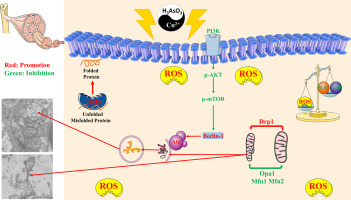Journal of Inorganic Biochemistry ( IF 3.9 ) Pub Date : 2018-08-04 , DOI: 10.1016/j.jinorgbio.2018.08.001 Yu Wang , Hongjing Zhao , Yizhi Shao , Juanjuan Liu , Jinglun Li , Liyang Luo , Mingwei Xing

|
Autophagy is an ubiquitin proteasome system for degradation of intracellular damaged proteins and organelles. Both as environmental pollutants, flourishing data show arsenic (As) and copper (Cu) as robust oxidative stress inducers. Whether this kind of damage correlates with autophagy through the phosphoinositide-3-kinase/protein kinase b/mammalian target of rapamycin (PI3K/AKT/mTOR) pathway still remains elusive. A 12-week exposures of Cu or/and As to chicken time-dependently displayed significant element residue in the pectoralis. Aligning with previous results, a strong pro-oxidant nature of Cu and As was clearly indicated by enzyme/nonenzyme antioxidants. Fragmented mitochondria induced by oxidative damage were accompanied by overexpressed dynamin related protein-1 and decreased mitochondrial fusion-related genes. Upon comparative analysis, time-dependent conversion of light chain 3 (LC3)-I to LC3-II, increases in autophagy-related genes such as Bcl-2-interacting protein (Beclin-1) and inhibited PI3K/AKT/mTOR pathway firmly supported the fact that Cu or/and As induces autophagy. These results further coincided with ultrastructure showing clusters of vesicles and autophagosome in the skeletal muscle. Interestingly, the time-dependently elevated heat shock proteins observed in Cu or/and As treated chicken suggest the continuous adaptation and physiological acclimation of organisms to this stress responses. Interestingly, the combination of copper and arsenic elicited more serious oxidative damage and its-cascaded injuries than their individuals. Together, our results showed that after Cu or/and As insult and accumulation, inhibited PI3K/AKT/mTOR pathway activated autophagy and disturbed mitochondrial dynamic, forming a positive feedback with redox disorder.
中文翻译:

铜或砷和砷通过氧化应激相关的PI3K / AKT / mTOR途径和鸡骨骼肌线粒体级联裂变诱导自噬
自噬是一种泛素蛋白酶体系统,用于降解细胞内受损的蛋白质和细胞器。既是环境污染物,繁荣的数据也表明砷(As)和铜(Cu)是强大的氧化应激诱因。这种损伤是否与通过雷帕霉素的磷酸肌醇-3-激酶/蛋白激酶b /哺乳动物靶标(PI3K / AKT / mTOR)途径的自噬相关仍然尚不清楚。鸡对铜或/和砷的12周暴露时间依赖性地显示了胸大肌中的大量元素残留。与以前的结果一致,酶/非酶抗氧化剂清楚地表明了Cu和As的强促氧化剂性质。氧化损伤诱导的线粒体片段化,伴随着过表达的dynamin相关蛋白-1和线粒体融合相关基因的减少。经过比较分析,轻链3(LC3)-I到LC3-II的时间依赖性转化,自噬相关基因(例如Bcl-2相互作用蛋白(Beclin-1))的增加以及PI3K / AKT / mTOR通路的抑制均支持以下事实Cu或/和As诱导自噬。这些结果还与超微结构相吻合,超微结构显示出骨骼肌中的囊泡和自噬小体簇。有趣的是,在铜或/和砷处理过的鸡中观察到的时间依赖性升高的热激蛋白表明生物体对该应激反应的持续适应性和生理适应性。有趣的是,铜和砷的组合比其个体引起更严重的氧化损伤及其连锁伤害。在一起,我们的结果表明,在铜或/和砷的污染和积累之后,


























 京公网安备 11010802027423号
京公网安备 11010802027423号